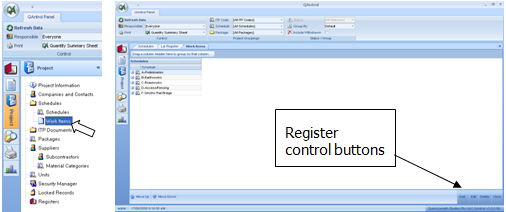Work Items
Navigate to the Work Items Register
To navigate to the Work Item register in QAntrol:
1.Select “Project” from the main menu;
2.The Project sub menu appears;
3.Select “Schedules”, expand this selection and select “Work Items”, the “Work Items” register appears.
4.Register entries or changes are made using the register control buttons located on the bottom left hand side of the screen.

Available View Options for the Work Item Register
The “Work Item” Register has two options for viewing the register information:
•Schedule View: Default display and is structured to group Work Items under their allocated Schedules and Sub-Schedules. This view will display when you open the “Work Item” register. The view will display Parent rows as the “Schedules” with Child rows beneath which can be expanded to display both Sub-Schedules and Work Items.
•Work Item View: Displays all available information in a grid allowing improved sorting and filtering using the functionality described in the “Getting Started” section of this manual.
To switch between “Schedule” and “Work Item” views:
1.In the “Work Items” register, go to the “Status/Group” toolbar located in the row above the register and select “Work Item” in the pull down menu located in the “Group By:” field

2.Select “Refresh” and the “Work Item” View will display.
Explanation of the Columns Displayed in the Work Items Register
The “Work Item” Register will display the following columns in the register:
Column Header |
Functionality |
|---|---|
Item |
The “Item” column displays an alpha and/or numeric short form (generally no more than 3-6 digits) identifier code used to aid “Work Item” selection and identification in other QAntrol registers. |
Description |
The Item “Description” column displays the title or description defining the work covered by the Work Item. |
Schedule |
The “Schedule” column displays the Schedule Code/identifier & Description linked to each Work Item. The Code and Description are separated by a hyphen. |
Unit |
The “Unit” column displays the unit of measurement for each Work Item |
Tender Quantity |
The “Tender Quantity” column reports the quantity of work priced in the Tender Bid Estimate for each Work Item. |
Sell Rate |
The “Sell Rate” column displays the selling rate to the Client for each Work Item and includes for all costs related to direct, indirect and margin. The sell rate is used to calculate revenue. |
Budget Rate |
The “Budget Rate” column displays the direct cost rate for each work items and includes only the direct costs associated with completing the work (i.e. excludes overhead and margin). The direct cost rate is used for productivity comparisons. |
Tender Value |
Calculated field: “Tender Value” = “Tender Quantity” x “Sell Rate” |
Sub-Schedule 1 |
Sub-Schedules maybe created within the Work Item Register and allow sub-grouping of common Work Items below the Parent Schedules (Refer “Schedules” section). The hierarchy for Sub-Schedule 1 is that it will sit directly below the Parent Schedule. The benefit of using Sub-Schedules are: oSub-Schedules may be linked to Lots and provide clear Lot definition and improve Lot tracability; oUse of Sub-Schedules in the Lot register filter associated Work Items aiding their selection in the Lot editor by use of the “Populate” button. |
Qty To Date |
Calculated field: Displays the actual quantity to date for a Work Item. Work Items maybe linked to individual Lots and assigned “Lot quantities” on a lot- by-lot basis. The “Qty To Date” = ∑ “Work Item Lot Quantities”. |
Sub-Schedule 2 |
Sub-Schedules maybe created within the Work Item Register and allow sub-grouping of common Work Items below the Parent Schedules (Refer “Schedules” section). The hierarchy for Sub-Schedule 2 is that it will sit directly below Sub-Schedule 1. |
ITP Code |
Displays the ITP Code linked to the Work Item. Work Items maybe linked to individual Inspection and Test Plans. The benefits of linking Work Items to an ITP are: oProvides a clear process for the identification of the type and number of Inspection and Test Plans required on the Project; oOutlines and gives clarity to the scope of work to be addressed in the preparation of the associated Inspection and Test Plan. |
% Complete |
Calculated field: Display the ratio “Value to Date” / “Tender Value” expressed as a percentage. |
Value to Date |
Calculated field: “Value to Date” = “Qty to Date” x “Sell Rate” |
Order |
Displays a numerical number that can be used to define an ascending sort order for Work Items the grid. |
